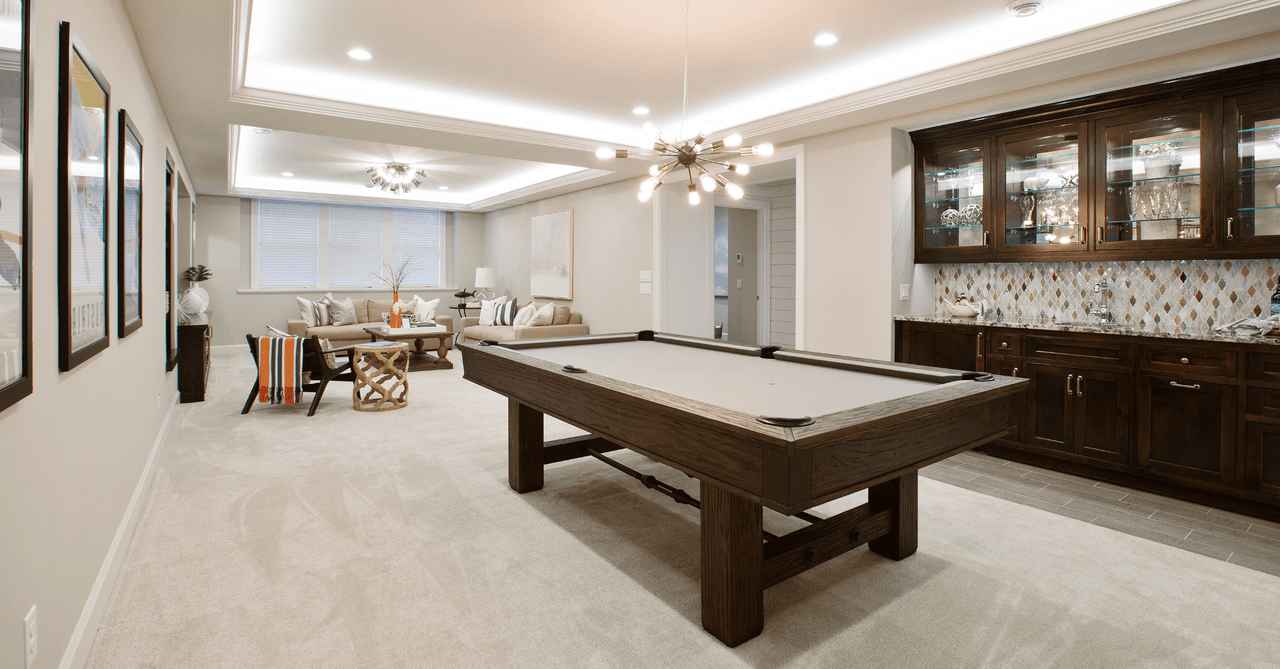
Are you planning on renovating or building a basement, and have some questions about ceiling heights? Keep reading to get just the information you are looking for!
What is the minimum basement ceiling height in Canada?

Source: Canva
First off, note that there is no maximum ceiling height requirement for basements. As for the minimum heights established by current standards, these vary from one room to another.
In the kitchen, hallways, laundry room, and bathroom, the ceiling height should be at least 7 feet (83 inches). The same applies to the bedrooms, main living room and dining room (in the case of finished basements, meaning it has been converted into a living space).
However, as we mentioned in a previous article on the standard ceiling heights for a house, some parts of the basement can have a minimum height of six and a half feet (78 inches). The following rooms are included in this standard:
Hallways;
Secondary entryway;
Entire basement if it is unfinished;
Secondary living room;
Secondary dining/kitchen area.
Are you looking to transform your basement into living quarters? Check out our article Creating a Basement Apartment: What to Know!
Can you deviate from the typical height requirements?
In order to comply with Quebec's Construction Code (and the National Building Code of Canada), the current standards regarding finished basement ceiling heights (and ceiling heights in general) must be respected by builders as they were established to ensure both the comfort and safety of residents, whether that may be for a finished basement, ground floor, or upper levels.
How low is too low for finished basement ceilings?

Source: Canva
The impulse to lower the basement ceiling can be desirable for a number of reasons. In fact, some people appreciate the feeling of a more enclosed space. Nevertheless, note that anything below 7 feet for common areas and bedrooms is too low, and anything lower than 6.5 feet is too low for bathrooms and other areas.
If that is the look and feel you are going for, you may want to install a stretch ceiling (PVC ceiling fabric). However, should you choose this route, note that this type of material should be installed according to a specific procedure: Stretch the fabric with a heat gun. Soundproofing panels (such as SONOpan) can be installed over the fabric for added soundproofing and/or thermal insulation. Note that this is an expensive option, and repairs will need to be made if the fabric tears. Nevertheless, it is easily removed and available in a variety of finishes, making it a worthwhile option.
It is also possible to opt for a suspended ceiling (drop ceiling). This type of ceiling has the advantage of being relatively easy and quick to install. Drop ceiling tiles are rather inexpensive and can be easily removed and replaced, allowing quick access to any plumbing or electrical systems hidden therein.
Unfortunately, the variety of tile models currently on the market does not allow for original design choices as is possible with PVC. Besides, a drop ceiling will limit the available height much more than a stretched ceiling would.
As a matter of fact, if you are using QuickHang hooks, it is not recommended to install a drop ceiling within 4 inches of a drywall ceiling, 3 inches from the joists, and 2.5 inches below the joists. Typically, there will be an inch of clearance between the ceiling and the material (or fabric).
Brief Mention About Sloped Ceilings
While sloped ceilings are not as common, knowing the standard height to be met could come in handy. As such, if one room has a sloped ceiling, it means that the ceiling must be 7 feet across 50% of the space.
Get 3 renovation quotes for your ceiling renovation project
RenoQuotes.com can help you get quotes for your home renovation project. By submitting your project, we’ll put you in contact with top-rated contractors. Fill in the form on the homepage (it only takes a few minutes), and you will get estimates from trusted professionals.
Dial 1-844 828-1588 to speak with one of our customer service representatives.
Looking for something else?
Related articles
The latest industry news, interviews, technologies, and resources.

Editorial Team
•07 Nov 2023
Small rooms in the home require ample planning in order to set the right tone. Lighting is an integral part of this process, as excellently designed and placed lighting and fixtures can help a space to really shine.

Christine Simard
•07 Nov 2023
With fall at our doors, the feeling of wanting to cuddle up in a cozy blanket with a hot beverage is being felt by many. While in relaxation mode, your bedroom's ambiance will play an important role on your mood. This is why the colour of your walls should be chosen according to what you want to reflect.

Editorial Team
•08 Aug 2025
Do you think it’s complex to put together a construction company’s marketing strategy? Well, think again! Marketing in the construction industry is based on the same fundamental concepts that govern all of marketing.

Editorial Team
•07 Nov 2023
For the novice DIYer, a plumbing project can at first appear challenging. Regardless if your project entails clearing clogs, expanding pipes, fixing leaks, or installing new appliances, these projects need to be carefully completed with tact and patience.

Editorial Team
•17 Jan 2025
Has your son or daughter grown up a lot and their childhood bedroom isn’t cutting it anymore? Well then, it’s about time to redecorate their slice of heaven to revamp their bedroom according to their personality and the young adult they’re quickly becoming. Here are some ideas to serve as inspiration for your teenager’s future bedroom design project!